Covid-19 66
Poliomielitis, Covid-19 y el Socialismo
Poliomielitis, Covid-19 y el Socialismo
Por Louis Proyect
14 de marzo de 2020
Traducido por Walter Lippmann por CubaNews.
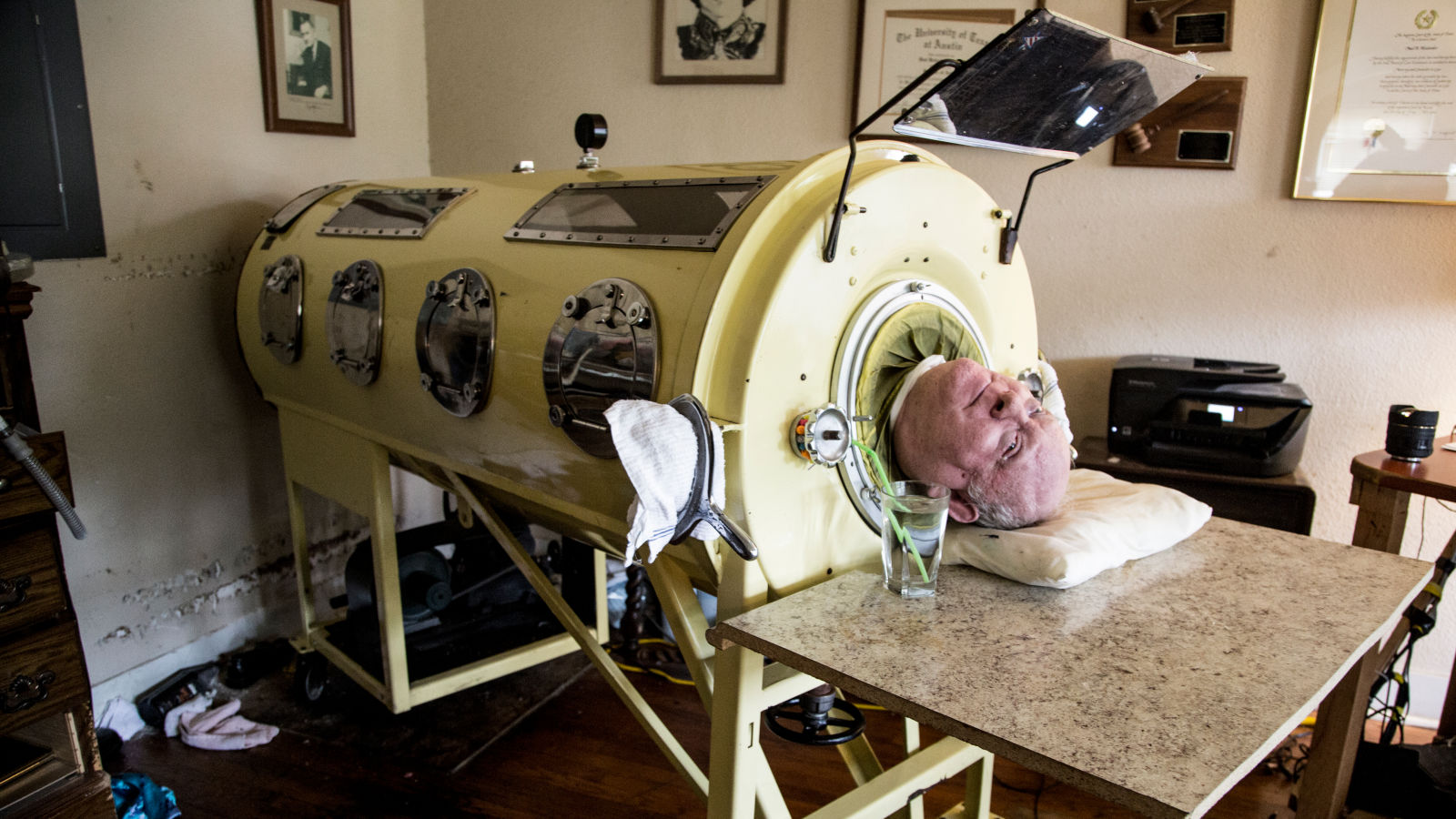
Paul Alexander, uno de los pocos supervivientes que quedan, pasa casi todo el día dentro de su pulmón de acero.
En 1952, cuando yo era muy joven, el miedo se apoderó de mi pequeño pueblo en Catskills y también de todo Estados Unidos. Ese año, sesenta mil niños se vieron afectados por el virus de la poliomielitis, que dejó 3.000 muertos y a miles más paralizados. Algunos niños fueron mantenidos con vida en un pulmón de hierro que funcionaba como el ventilador de hoy en día, pero que los mantenía confinados en un virtual ataúd viviente.
A ese verano lo llamaron la “estación de la polio”. En Woodridge, teníamos el lago Kaplan, un estanque mas bien, en el que nadaban los niños de por allí. Yo iba allí principalmente a caminar cerca de la playa. Un verano, nuestros padres nos dijeron que lo iban a cerrar por la epidemia de la polio. También nos advirtieron que no nos sentáramos demasiado cerca en los cines, un verdadero problema cuando la última película de Martin y Lewis tenía a los niños haciendo cola alrededor de la manzana para comprar una entrada en el Lyceum Theater de Woodridge.
FDR fue probablemente la víctima de la poliomielitis más conocida en Estados Unidos, pero muchos otros padecieron la enfermedad, como Neil Young y Francis Ford Coppola, que tuvieron casos más leves. Patrick Cockburn, nacido en 1950, enfermó de polio a los seis años. En 2005 escribió un libro sobre su experiencia, titulado “The Broken Boy” (El chico roto). En una entrevista con NPR ese año, el presentador le dijo: “Te quedó una cojera, una cojera severa. Pero usted entrevistó a otros supervivientes que estaban realmente mucho peor”. Cockburn respondió:
Sí, muchos de ellos. Un hombre que se convirtió en empresario tuvo que aprender a firmar su nombre con los dientes, con un bolígrafo clavado en los dientes y un aparato especial. A muchos otros les afectó la espalda, los pulmones y las piernas. Pero mucha gente se defendió. Conocí a un agricultor que tenía miedo de que cuando volviera a casa, por estar tan lisiado, la gente no lo aceptara. Pero, en realidad, su familia -y las familias irlandesas son muy fuertes- readaptó la granja para que pudiera manejar la maquinaria agrícola, para que pudiera ser un agricultor trabajador. Y muchas otras personas lucharon contra dificultades extraordinarias.
Para muchos médicos, el objetivo de desarrollar una vacuna para prevenir la polio se convirtió en algo primordial. FDR fundó la Fundación Nacional para la Parálisis Infantil en 1938 y promovió la Marcha de las Monedas de 10 centavos para la investigación de la polio. Cuando Harry Truman llegó a la presidencia, se comprometió a luchar contra la poliomielitis utilizando un lenguaje que recordaba al New Deal de los años 30:
La lucha contra la parálisis infantil no puede ser una guerra local. Debe ser a nivel nacional. Debe ser una guerra total en cada ciudad, pueblo y aldea del país. Porque sólo con un frente unido podemos esperar ganar cualquier guerra.
Dos médicos investigadores, judíos de Nueva York, fueron fundamentales en el desarrollo de una vacuna. Ninguno de ellos vio esto como una forma de hacerse rico. Su objetivo era únicamente salvar la vida de los niños.
Nacido en Nueva York en 1914, Jonas Salk desarrolló en 1955 una vacuna basada en virus muertos de la polio. El respaldo a su proyecto fue universal, con 100 millones de contribuyentes a la Marcha de las Monedas de 10 centavos, y 7 millones de voluntarios caminando por las calles con el emblemático banco colector.
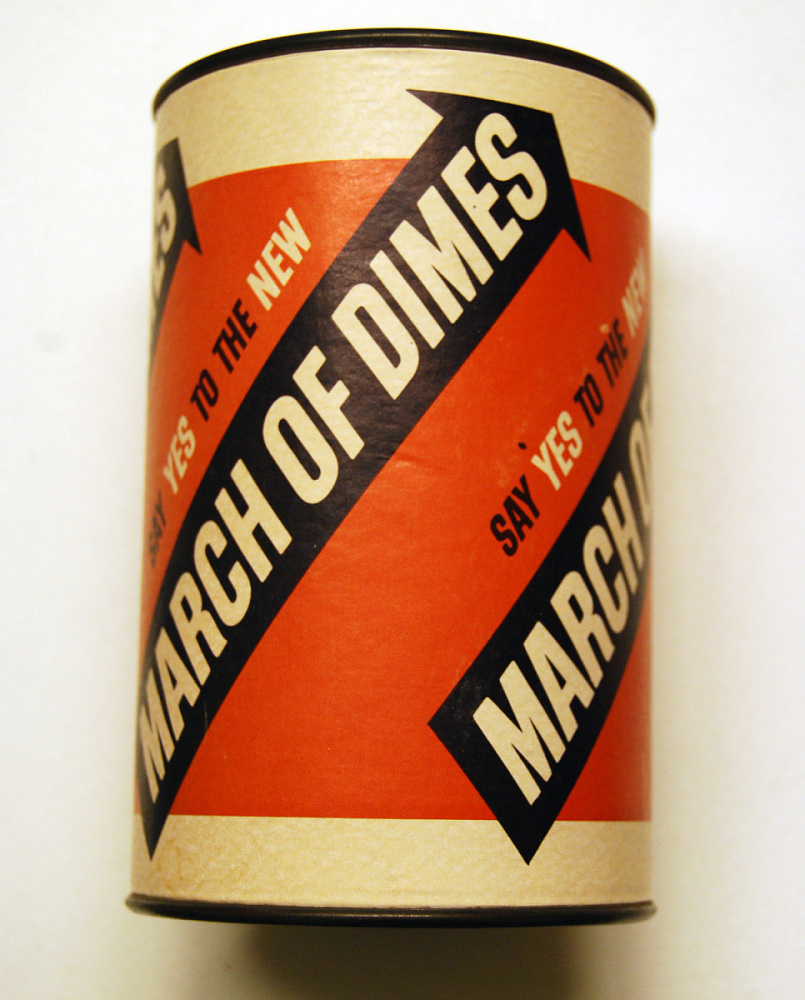
Collection bank. 2005.3016.11.
Salk podría haber ganado millones patentando la vacuna, pero prefirió que estuviera lo más disponible posible. Cuando acudió al popular programa “Person to Person” de Edward R. Murrow, el presentador le preguntó a quién pertenecía la patente. Salk respondió: “Bueno, yo diría que a la gente. No hay ninguna patente. ¿Podría usted patentar el sol?” (Si se hubiera patentado, valdría 7.000 millones de dólares).
Da la casualidad de que Salk se graduó en el CCNY, un semillero de radicalismo en la década de 1930. No es de extrañar que J. Edgar Hoover tuviera su número. Cinco años antes de que presentara la vacuna, fue objeto de una investigación del FBI. Al escribirle a Dillon Anderson, uno de los más cercanos ayudantes de Eisenhower, Hoover recapituló sus transgresiones:
•Tres asociados no identificados de Salk, profesores de la Universidad de Michigan, dijeron que durante la Segunda Guerra Mundial Salk contribuyó a la ayuda de guerra para la Unión Soviética y fue “muy abierto” en sus elogios a ese país. Los asociados dijeron que Salk elogió los avances técnicos del país, mientras que su esposa, Donna, era aún más abierta en sus elogios a todos los aspectos de la vida soviética, escribió Hoover.
•Uno de los asociados profesionales de Salk en la U-M en la década de 1940 dijo que Salk estaba “muy a la izquierda del centro”. Otro asociado señaló que una organización liberal de la que Salk fue tesorero en 1946 se convirtió en “izquierdista” bajo el liderazgo de Salk.
•Salk y su esposa se inscribieron para votar al Partido Laborista Americano a principios de la década de 1940, dice la carta. Según un informante, el Partido Comunista se convirtió en una fuerza de control del ALP dentro de las áreas de la ciudad de Nueva York durante ese tiempo.
•Un informante informó que el hermano de Salk, Lee, era miembro del Partido Comunista en Ann Arbor en 1948.
•Según un informante, dijo Hoover, el nombre de Salk apareció en la lista de correo de la Conferencia de Nueva York por los Derechos Inalienables en 1941. El grupo fue citado como fachada comunista por el Comité de Actividades Antiamericanas de la Cámara de Representantes.
Nacido como Albert Saperstein en Bialystok, Polonia, en 1906, Albert Sabin se licenció en medicina en la Universidad de Nueva York, al igual que Salk. A diferencia de Salk, el objetivo de Sabin era desarrollar una vacuna basada en el virus debilitado de la polio. Ambas vacunas funcionaron, pero la de Sabin tenía la ventaja de poder tomarse por vía oral y ser más duradera.
Desafiando la histeria de la Guerra Fría, Sabin trabajó estrechamente con médicos y científicos del bloque soviético, lo que le valió la reputación de trabajar en una “vacuna comunista”. En un artículo titulado “La vacunación y el Estado comunista: la poliomielitis en Europa del Este”, Dora Vargha concluye que los Estados comunistas eran capaces de “hacer cosas buenas”, como ha dicho Bernie Sanders:
Tanto Oriente como Occidente compartían la percepción de lo que era el Estado comunista y su papel ideal en la prevención de la poliomielitis. Tras la aparición y la aplicación con éxito de las vacunas con poliovirus vivos, los estados de Europa del Este se consideraron especialmente aptos para lograr la eficacia en la contención -y erradicación- de la poliomielitis gracias a su participación en el desarrollo de la vacuna y su distribución. Occidente, aunque no respaldaba ideológicamente estos regímenes políticos, estaba de acuerdo. De hecho, Checoslovaquia, Hungría y Polonia se convirtieron en pioneros en la introducción, prueba y aplicación de vacunas de poliovirus vivo a escala masiva, mientras que sus pares de Europa del Este se apresuraron a seguirles en la vacunación masiva.
Desde una perspectiva geopolítica más amplia, la poliomielitis planteó cuestiones incómodas sobre el lado positivo de los regímenes comunistas (es decir, el control eficaz de las epidemias) y en poco tiempo llegó a simbolizar la ciencia “neutral” que rompía las barreras entre Oriente y Occidente. La organización vertical de los ensayos de vacunas y la inmunización, que en aquel momento se consideraba especialmente comunista y de Europa del Este, también pasó a considerarse la forma más eficaz de erradicar la poliomielitis a escala mundial.
Sabin continuó colabronado con las demonizadas sociedades post-capitalistas mucho tiempo después. En un artículo de 2014 titulado “Epidemias y oportunidades de colaboración entre Estados Unidos y Cuba”, Marguerite Jiménez describió su perspectiva internacionalista:
Varios años después de su apertura a la colaboración con la Unión Soviética, Sabin puso sus ojos en un colaborador comunista mucho más pequeño, uno que estaba mucho más cerca de casa. Sabin había viajado a Cuba varias veces antes de la revolución cubana de 1959, pero no había podido volver desde principios de los años cincuenta. A pesar de haber recibido múltiples invitaciones de funcionarios de salud pública de la isla a principios de la década de 1960, la escalada de las hostilidades entre Estados Unidos y Cuba hizo casi imposible una visita de tan alto perfil por parte de un famoso científico estadounidense.
La entusiasta búsqueda de Sabin de oportunidades de colaboración con la Unión Soviética durante la década de 1950 presagió sus esfuerzos en Cuba por superar los obstáculos políticos y el melodrama diplomático. En consecuencia, a finales de 1965, cuando el Departamento de Estado anunció una relajación de las restricciones a los viajes a las naciones comunistas por parte de ciertas categorías de profesionales, Sabin aprovechó rápidamente la oportunidad. El Departamento de Estado informó de que la relajación había respondido a la “insistencia de la comunidad médica” y se había hecho por razones de “humanidad” para promover una mayor cooperación internacional en la lucha contra las enfermedades. Aunque la investigación médica justificaba el carácter humanitario de la medida, el New York Times informó de que “la esperanza en los círculos oficiales era que los científicos médicos pudieran abrir la puerta a una cooperación más estrecha en otras áreas científicas.” Sabin envió inmediatamente copias del anuncio a sus colegas en Cuba y en veinticuatro horas recibió una invitación a través de la Misión Permanente de Cuba ante las Naciones Unidas.
Finalmente, tras casi dos años de planificación, Sabin llegó a La Habana el 4 de diciembre de 1967. Durante su estancia en Cuba, tuvo la oportunidad de visitar y reunirse con personas de una amplia gama de instituciones científicas y médicas, así como de hospitales, policlínicas e instalaciones de investigación. Aunque otros elementos de su viaje se hicieron públicos gracias a un puñado de artículos periodísticos sobre el tema publicados tanto en Estados Unidos como en Cuba, lo que no es comúnmente conocido es que durante su viaje, Sabin se reunió con Antonio Núñez Jiménez, un joven y prominente líder dentro del régimen de Fidel Castro y presidente de la Academia de Ciencias de Cuba. Sabin describió a Jiménez como una persona “de armas tomar” y “muy agradable”.
Ayer me acordé de Salk y Sabin tras leer un informe del Instituto de Investigación Sunnybrook, un hospital asociado a la Universidad de Toronto. Titulado “El equipo de investigación ha aislado el virus COVID-19”, revelaba que el Dr. Robert Kozak, la Dra. Samira Mubareka y el Dr. Arinjay Banerjee habían aislado el coronavirus del síndrome respiratorio agudo severo 2 (SARS-CoV-2), el agente responsable del actual brote de COVID-19.
Esa información sería fundamental para desarrollar una vacuna. Al describir su descubrimiento, Arinjay Banerjee se mostró muy en la tradición Salk/Sabin: “Ahora que hemos aislado el virus del SRAS-CoV-2, podemos compartirlo con otros investigadores y seguir trabajando en equipo. Cuantos más virus estén disponibles de este modo, más podremos aprender, colaborar y compartir.”
Colaborar y compartir. Eso no sólo es necesario para superar el COVID-19, sino para salvar al mundo de la destrucción capitalista.
Farhad Manjoo, uno de los únicos columnistas de opinión del New York Times que se pueden leer, estaba en lo cierto cuando escribió que “todo el mundo es socialista en una pandemia”. Escribió:
Puede haber un resquicio de esperanza: ¿Y si el virus obliga a los estadounidenses y a sus representantes a reconocer la fuerza de un ethos colectivista? El coronavirus, de hecho, ofrece algo así como un anticipo de muchas de las amenazas a las que podríamos enfrentarnos por los peores efectos del cambio climático. Como el virus no discrimina y es casi ineludible, nos deja a todos, ricos y pobres, en el mismo barco: La única manera de que cualquiera de nosotros esté realmente protegido es si el más pequeño de nosotros está protegido.
Amén.
…
The Virus of Inequality

The virus of inequality or inequality in the virus
Two reports warn of a truth, the deadly Covid-19 pandemic has increased inequities and global differences and although anyone can get sick, those with lower incomes add up much more in the statistics, are poorer and will have less access to the hopeful vaccine …
Author: Juana Carrasco Martin

Translated and edited by Walter Lippmann for CubaNews.
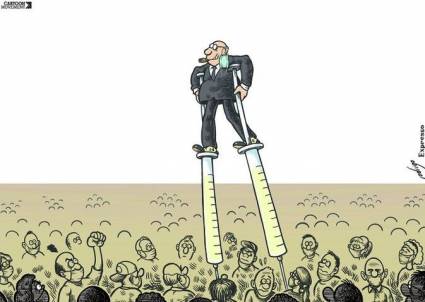
The combined wealth of ten of the world’s richest people could pay for vaccines to immunize everyone Author: Twitter Published: 02/02/2021 | 03:38 pm
Oxfam has been adamant that the combined wealth of the world’s ten richest people could pay for vaccines to immunize the entire world. At the same time, the International Labor Organization stated in a report that the Covid-19 pandemic has caused the loss of 255 million jobs.
Social inequity, unequal opportunities to access goods and services such as housing, education or health are among the consequences of the world’s health situation, where more than 103 million people have fallen ill and more than two million have died, and the count continues, while the vaccines already in use, which are not enough and are the object of disputes between first world countries that can afford them and are among their manufacturers, do not seem to be distributed fairly….
Those who have called it the virus of inequality are right. Here are some data that prove it.
The Oxfam report is titled “The Inequality Virus: Reuniting a coronavirus-torn world through a fair, just and sustainable economy,” and it announces all that it means and is needed.
Paul O’Brien, vice president of Oxfam America, in an interview with Democracy Now, noted of the pandemic situation: “The 10 richest people ended up making half a trillion dollars during the pandemic. The richest thousand got back all the money they lost in the pandemic, and they reached the same level of wealth in nine months. But at the same time, it has been disastrous for people at the extreme end of poverty.”
The report of this international confederation of 19 non-governmental organizations, which carry out humanitarian work in 90 countries under the slogan “working with others to combat poverty and suffering”, as they describe it on the Internet, warns that in the face of these exorbitant profits of billionaires, poor people will not recover from the economic and health crisis for at least a decade. If it does, it should be noted.
“In every country we looked at, inequality has worsened during the pandemic,” O’Brien added.
The Economic Commission for Latin America and the Caribbean (ECLAC) pointed out that this economic crisis and the slow exit from it will lead to the closure of 2.7 million companies in the region alone and some 8.5 million more workers will lose their jobs, in an emergency that by 2020 had already led to a significant drop in growth and economic contraction.
The economic recovery will be fragile and uneven, is the sharp forecast of ECLAC; the painful conclusion for millions of Latin Americans and Caribbeans who were already going through a limited growth, to which now add the consequences of the pandemic as the lower export of raw materials and the collapse of tourism, among other indices in decline.
ECLAC’s Executive Secretary, Alicia Bárcena, added other significant data in red: 54 percent of the region’s labor force does not have social protection or access to public health services.
Of this proportion, 57 percent are women, and this index added an aggravating factor that is reproduced in other regions of the world, even in developed countries. The International Labor Organization also brought its concerns to the 51st World Economic Forum in Davos, which met virtually this week and not in its usual snowy retreat in the Swiss Alps.
Globally, the pandemic cost workers $3.7 trillion in lost income and the destruction of the equivalent of 255 million jobs in 2020, four times the impact of the 2009 global financial crisis, the ILO reported.
But the summit meeting of politicians, businessmen and representatives of social and cultural organizations, which this time did not take place as usual in Thomas Mann’s Magic Mountain, did not exactly provide prodigious solutions at a peremptory moment for the planet. On the contrary, the widespread resurgence of the coronavirus, and even the new strains, highlighted the old weaknesses of health systems around the world, the injustices, the inaccessibility to medical care and vaccination that should be for everyone.
The slogan “The Great Reset” was crushed by an avalanche, and in this January 2021, as in the novel of the great writer, the problems discussed at the Davos Forum and the lack of intention to address them from what is fair, can be seen as the decadence of a way of life where the selfishness of those who only count profits in their finances over world health takes precedence.
The pandemic is conjunctural, although of extreme gravity. That is why its combination with structural problems, the same ones year after year, multiply the effects of inequity.
Check it out in these statements by Ursula von der Leyen, president of the European Commission, when the bloc intensified stricter monitoring of vaccine exports to countries outside the union. This is the case of the United Kingdom, because they had invested billions of euros and that “companies must now deliver” their vaccines to the 27 member states. “… We will set up a transparency mechanism for vaccine exports. Europe is determined to contribute. But it also means business.”
Ultimately that is the transparent truth,. The EU is a union of high-income rich countries, home to 342 billionaires; however, 123 million people at risk of poverty also reside there, Oxfam reported.
So what should we leave for the always neglected Africa? Cyril Ramaphosa, president of the African Union and of South Africa – one of the countries most affected by the coronavirus and even contributing a new strain, apparently of greater spread and lethality -, during his speaks at the 51st edition of the Davos Economic Forum, rightly criticized what he defined as “vaccine nationalism”, that is, the implementation of this selfish and inhuman attitude of hoarding, which hinders an equitable distribution of vaccines. “The rich countries of the world went out and acquired large doses (…) Some even acquired up to four times more than what their population needs excluding other countries”, a denunciation that he joined to the substantial comment: an increase in poverty is “expected for the first time in decades” and added, “the challenges we face were not created by the virus, they were created by us”.
You and I are not “us”, it is clear who fall into that category in the current pandemic and in the ancestral ills of that continent, the most powerful nations of the world that were colonial or neo-colonial empires.
The AFP news agency commented in this regard that bilateral agreements between governments and companies manufacturing vaccines against the Covid-19 virus could raise the prices of the drug and limit its supply to some regions.
Of course, the EU is not alone in this hoarding, where the United States and Donald Trump’s promise-threat that his country would be the first to be immunized and the willingness to buy all the vaccines produced in the world takes the lead.
Ramaphosa ratified the necessary denunciation: “We are concerned about vaccine nationalism (…) The rich countries of the world are holding on to these vaccines and we say: release the excess vaccines you have ordered and stockpiled”.
Reuters reported these days that the United Kingdom ordered 367 million doses of seven different vaccines for its population of approximately 67 million inhabitants, and the European Union secured almost 2.3 billion doses for a population of 450 million inhabitants.
However, the African continent, with some 1.3 billion inhabitants, barely completed 600 million doses of the international vaccine Covax, under the aegis of the WHO, which is also being requested by the rich countries.
We are faced with the confirmed presence of inequality in the midst of the terrible coronavirus.
Vaccination against selfishness and inequality

Vaccination against selfishness and inequality
By: Randy Alonso Falcón
January 27, 2021
Translated and edited by Walter Lippmann for CubaNews.
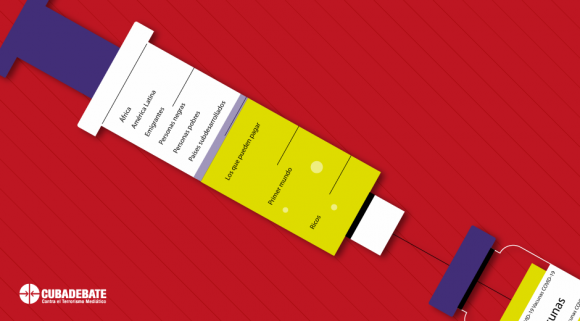 “It will not be an exhausted and outdated world order that can save humanity and create the indispensable natural conditions for a dignified and decent life on the planet. (…) This is not an ideological question; it is already a question of life or death for the human species.”
“It will not be an exhausted and outdated world order that can save humanity and create the indispensable natural conditions for a dignified and decent life on the planet. (…) This is not an ideological question; it is already a question of life or death for the human species.”
Fidel Castro Ruz
Speech at the Open Tribune of the Revolution, held in San José de las Lajas
January 27, 2001
Solidarity and Justice are still words in disuse even when the catastrophe concerns us all, like a great universal Titanic. A tiny and sticky virus has moved fears, shaken societies and health systems, provoked countless reflections on today and the future, but it has not succeeded in making equity and love for others prosper.
This week will mark the 100 millionth person infected with COVID-19 in the world and already more than 2 million people have died.
“Every day the gap between the haves and have-nots grows. The pandemic has reminded us that health and economics are linked and that we are all in the same boat. The pandemic will not end until it ends everywhere,” said World Health Organization Director-General Dr. Tedros Adhanom Ghebreyesus on Monday.
The numbers bear incontrovertible witness to the expert’s assessment.
The privileged cure
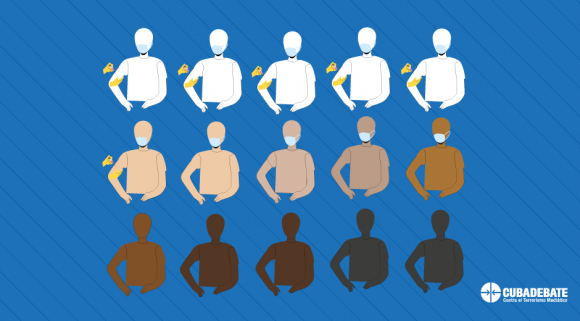
Despite numerous calls from the UN and various world leaders to seek a global response to the pandemic and to facilitate and share access to a cure for the disease, narrow views and deaf ears predominate.
“Science is succeeding, but solidarity is failing,” UN Secretary-General António Guterres noted on January 15. Several vaccines are already available worldwide to tackle the SARS-CoV-2 virus, but access to them is as deeply unequal as the world we inhabit.
Some 66.33 million doses have been administered to date, 93% of which were delivered in just 15 countries: the US, China, UK, Israel, United Arab Emirates, Germany, India, Italy, Turkey, Spain, France and Russia, according to the data analysis platform Our World in Data, based on figures from Oxford University.
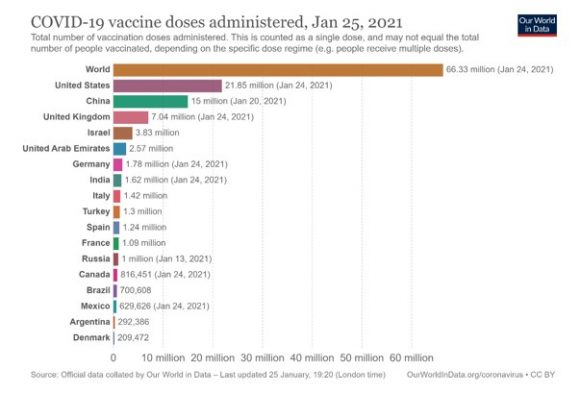
In all of sub-Saharan Africa, only 25 doses of vaccine could be administered in Guinea. Populous countries like Nigeria, with 200 million inhabitants, are waiting for the first dose.
The same scramble that took place at the beginning of the pandemic with lung ventilators, masks and protective suits is now being staged with vaccines: hoarding, overpricing and speculation. “An immoral race to the bottom,” as the WHO’s top executive described it.
The COVAX fund, created as a sort of global effort to make vaccines accessible to the poorest nations or those with limited resources, announced that in February it will begin to deliver the first doses (they first said that in January), but it recognizes that it has been limited by the lucrative agreements of various individual nations with the pharmaceutical companies that produce the anti-COVID vaccines.
Another handicap has been the high cost of the vaccines that have the most international approval so far. As Norwegian expert John-Arne Rottingen told The Guardian, “The difficulty is that we really only have widespread international approval for marketing two vaccines: the two mRNA vaccines. The challenge is that one, the Moderna vaccine is very expensive, and the other, the Pfizer / BioNTech vaccine, which was first available and is now being applied in Europe, is moderately expensive compared to others, and requires a super cold chain. The price and cold chain makes it not the ideal vaccines for a global vaccine.”
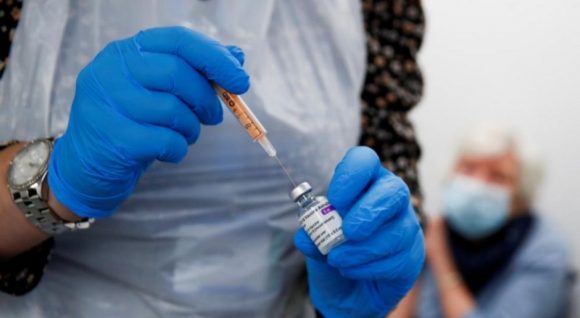
While nations like India and South Africa are calling on the WHO to campaign for pharmaceutical companies to relinquish intellectual property rights to COVID-19 vaccines and treatments. That would allow other qualified manufacturers in the South to expand production of those antidotes; countries like the US, UK and Canada have opposed the initiative. Those three wealthy nations have purchased or reserved enough doses to inoculate their populations at least four times.
High-income countries account for 16% of the world’s population, but hold more than 60% of the vaccines purchased so far.
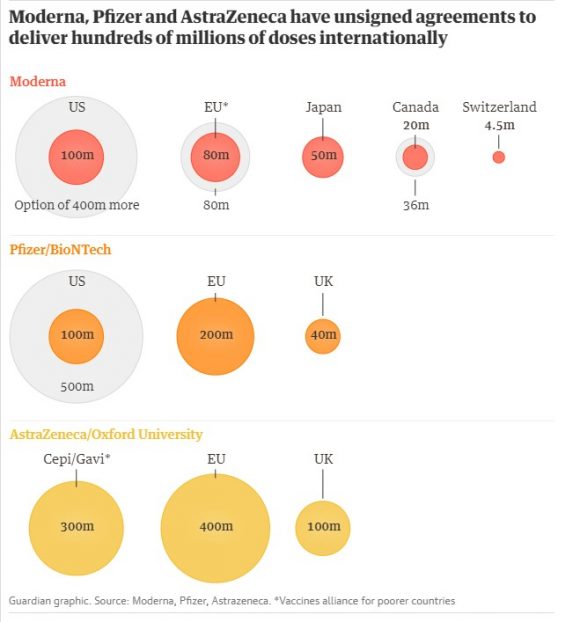
Rich countries account for the lion’s share of vaccine production. Graphic: The Guardian
Some forecasts put the total population of middle-income and poor countries that could be vaccinated this year at 27%. Duke University’s Center for Global Health Innovation estimates that there will not be enough vaccines to immunize the world’s population until at least 2023.
“The world is on the brink of a catastrophic moral failure, and the price of this failure will be paid in lives and livelihoods in the world’s poorest countries,” Dr. Tedros regretfully sentenced.
The virus of inequality
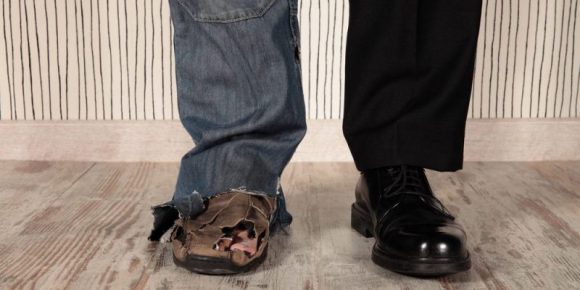
“Vaccine nationalism” is the exact reflection of an unequal and unjust world in which a few remain the great beneficiaries of wealth, for which billions must make do with the leftovers.
It is the “inequality virus” that OXFAM denounces in its most recent report, in which it evidences that the current failed economic system “allows a super-rich elite to continue to accumulate wealth in the midst of the greatest economic crisis since the Great Depression, while billions of people face great hardship to get by.”
While billionaires saw their fortunes increase between March and December 2020 by a total volume of $3.9 trillion-to amass an unimaginable $11.95 trillion-the poorest people on the planet will need “more than a decade to recover from the economic impacts of the crisis” accentuated by the COVID-19 pandemic.
Racial differences have also deepened. In the United States, the most powerful nation on the planet, if mortality rates were equal to those of the white population, nearly 22,000 Latinos and blacks would not have died from the coronavirus outbreak. In Brazil, people of African descent are 40% more likely to die from COVID than whites.
One of the conclusions of the Oxfam report is that “the pandemic is likely to increase inequality in a way never seen before”. The World Bank has warned that, in the current context, more than 100 million people could reach extreme poverty.
The 10 richest men in the world saw their net worth increase by $540 billion in the pandemic 2020 period. That list is topped by Jeff Bezos and Elon Musk. It also includes luxury group LVMH CEO Bernard Arnault, Bill Gates and Facebook CEO Mark Zuckerberg. According to Oxfam, the money hoarded by these potentates would be enough to prevent people from falling into poverty due to the effects of the virus and would also guarantee a vaccine for everyone on the planet.
Sunshine of the moral world
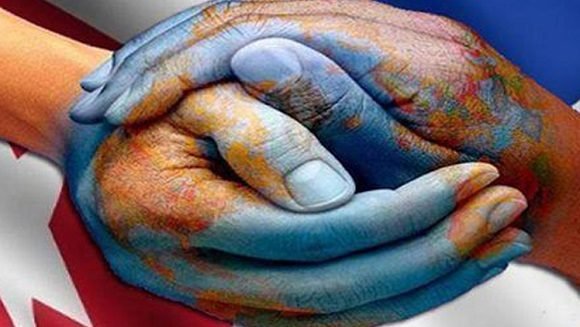
Among so much inequity and indifference, a small archipelago in the Caribbean, called Cuba, has been able to send thousands of doctors and nurses, in some 50 brigades of the “Henry Reeve” Internationalist Contingent, to more than thirty countries in Latin America and the Caribbean, Europe, Africa and the Middle East, to collaborate in the fight against the deadly disease.
Thousands of lives saved or recovered in a scenario of total complexity are the fruit of their solidarity work. The human and professional quality of these sons and daughters of the Cuban people overcomes the most diverse obstacles. It leaves a mark of affection, gratitude and example that is recognized by all those with whom they have shared and whom they have cared for.
That same country, with scarce economic resources but abundant in trained and educated talent, has been able to build an advanced biopharmaceutical industry, which is now preparing to produce 100 million doses of Soberana 02, one of the 4 vaccines on which its scientists are working. This would make it possible to immunize the entire Cuban population (it would be one of the first countries to achieve this) and to have more than 70 million doses available for other peoples of the South. There are already countries interested in acquiring it, such as Vietnam, Iran and Venezuela, Pakistan and India, the Director General of the Finlay Vaccine Institute recently announced.
Researchers from that institution are working with countries such as Italy and Canada to test the impact of the Soberana 01 vaccine on people who have already had COVID-19 and are convalescing, but are at risk of reinfection.
“We are not a multinational where (financial) return is the number one reason. We work the other way around, creating more health and return is a consequence, it is never going to be the priority,” Dr. Vicente Vérez, leader of the main vaccine research center in Cuba, explained to the press last week.
“Our world can only beat this virus one way: united,” the UN Secretary-General recently emphasized. Unfortunately, the vaccines of solidarity and justice have not been able to be applied in the rich world that dominates.
The Antigen of Cuban Vaccines

Vaccines and Sovereignty (III)
The Antigen of Cuban Vaccines Against Covid-19
By Luis A Montero Cabrera
January 21, 2021
Translated by Merriam Ansara for CubaNews and other outlets.
This is the third in a series of articles.
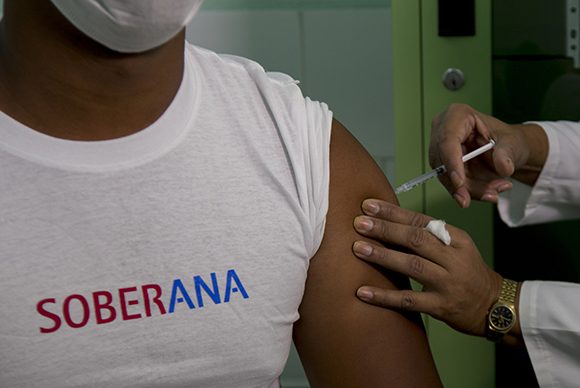
The application of the Cuban Sovereign vaccine candidate begins. Photo: Ismael Francisco/ Cubadebate.
We Cubans have a very remarkable platform for biomedical production, one might even say extraordinary for a country like ours. An infamous 2004 document from the “Commission for the Support of a Free Cuba” of a previous administration in the US described it as unnecessary and very expensive for such a poor country as ours: “Large sums were also directed to activities such as the development of biotechnology and bioscience centers not appropriate in magnitude and expense for such a fundamentally poor nation, and which have failed to be justified financially”. The only thing to be added to this is that those of us in the South with darker skin ought not to have the luxury of science. But our biopharmaceutical sector is the child of necessity, of the creative initiative of a lover of knowledge and a true revolutionary, as was our Fidel, and of an educational policy that gives everybody without distinction the right to reach the highest level of human knowledge and to with that knowledge, create. It was not begun with a specific strategy or goal but became, as it is today a bastion of the knowledge, science and culture of our country. It was and is the fruit of revolutionary thinking.
The development of a vaccine today requires the existence of today’s conditions for this kind of research. It must begin by looking at the scientific literature for antecedents and ways of doing things that can lead to the implementation of more and more exquisite laboratory procedures and rigorous tests. In our case and for the above reasons, a firm base for the research was already established when the COVID 19 emergency arose. Events such as these cannot be foreseen, but the preparation of the conditions to face them is the duty of any decent political system.
Chinese science immediately made available to the international community everything it knew about this dangerous and ultra-contagious virus and in other countries as well the information that was being generated was made available to all. Under these conditions, several of our scientific groups set to work to obtain a specific Cuban vaccine for this disease. One of the efforts, at the Finlay Vaccine Institute, is led by the same Prof. Vicente Vérez who obtained the previous milestone of the vaccine against “Haemophilus influenzae”, the first with synthetic antigens that was used and commercialized in the world. The other groups involved work at the Center for Genetic Engineering and Biotechnology with a long tradition also in the design and production of novel vaccines.
Remember that the essential component of a vaccine is the antigen that activates the immune system and leaves it ready to fight and destroy the foreign invader. Additional determining factors are both the adjuvants and the pharmaceutical forms for delivering the vaccine to humans. If you have an established and strong foundation in these last two aspects, determining the most suitable antigen becomes the heart of the creative work.
The antigen chosen in Cuba, for many reasons, was the “receptor-binding domain” of the virus (RBD). In simple terms, these are the molecules that constitute the external “spikes” so striking that they appear in the pictorial representation and the high-resolution microscopy of the viral molecular aggregate. This CoV “spike” protein (S) plays the most important role in viral binding, fusion and entry into cells of the organism attacked by the virus.
Therefore, it serves as a target for the immune system to develop antibodies, and for scientists to use them as antigens in the design of effective vaccines. An article that appeared in one of the branches of the well-known journal Nature had characterized this component as very promising as a vaccine antigen against COVID 19 as early as March 2020. The authors of the article are a very good reflection of the current internationalization of the basic sciences. Most are Chinese in origin and did extensive work in collaboration between the Lindsley F. Kimball Research Institute in New York, the Beijing Institute of Microbiology and Epidemiology, and the Key Laboratory for Medical Molecular Virology at Fudan University in Shanghai.
Our compañeros evaluated alternatives. One of them was to generate the so-called messenger RNA that was capable of producing the antigen in human cells. It is an ultra-modern technology that is being used in some of the COVID 19 vaccines that are already being applied. It has some advantages, but also has an important disadvantage so far not overcome for a vaccine that is intended to be administered massively throughout the world, especially the less developed one: it requires very strict cooling conditions for its transport and preservation.
Our biotechnology system, on the other hand, has at the Center for Molecular Immunology (CIM) the possibility to “ferment” mammalian cells that directly produce the RBD antigen, since the technology has been developed for other similar productions. It also has the possibility of producing a significant quantity if the antigen is viable for our vaccine. Therefore, all Cuban vaccine candidates, at least up to now, are based on this antigen, with some modification that makes it more active.
The results are exhilarating. And thus our scientists began the race to produce a variety of vaccines, in different institutions and by different scientific groups, collaborating and competing, in order to arrive at the best solutions. “SOBERANAS” 1 and 2, the MAMBISA and the ABDALA are very promising.
Vaccines are drugs. Therefore, they require measurements of their effectiveness, knowing their contraindications and risks, and finding the appropriate formulations and the most viable forms of administration before applying them en masse. Everything must proceed in a strict regulatory framework to ensure that consequences more serious than the disease itself were avoided. If they have the same antigen, how are our vaccine variants different? What state are they in their research and development?
Havana, January 20, 2021
 Luis Alberto Cabrera Montero holds a Doctorate Chemical Sciences. He is Senior Researcher and Full Professor at the University of Havana. He is President of the Scientific Advisory Council of the University of Havana and is a Merit Member and Coordinator of Natural and Exact Sciences of the Academy of Sciences of Cuba. For a full biography, see http://www.academiaciencias.cu/en/node/674
Luis Alberto Cabrera Montero holds a Doctorate Chemical Sciences. He is Senior Researcher and Full Professor at the University of Havana. He is President of the Scientific Advisory Council of the University of Havana and is a Merit Member and Coordinator of Natural and Exact Sciences of the Academy of Sciences of Cuba. For a full biography, see http://www.academiaciencias.cu/en/node/674
What are vaccines?

Vaccines and Sovereignty (II):
What are Vaccines?
By Luis A Montero Cabrera
January 11, 2021
Translated by Merriam Ansara for CubaNews and other outlets.
This is the second in a series of articles.
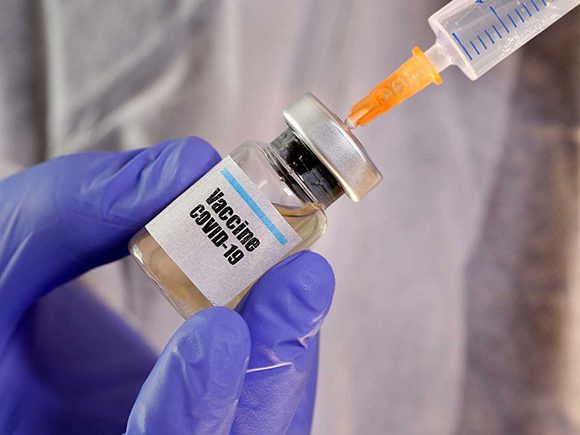
Seventy coronavirus vaccines are in development worldwide, and three are already being tested in human trials, the World Health Organization said. Photo: iStock
The molecules of an invading biological entity that are identified and are accessible to the human immune system are often referred to as “antigens”. They are usually expressed in the outermost parts of the nanoscopic carrier and are a necessary part of its composition. They are the same when found in a virus, in a fungus, in a bacterium, or in the cells of an organ from another being transplanted into our body.
An important characteristic of the infection and self-healing process is that when an individual overcomes a disease by the action of the immune system, it usually remains prepared to defeat it in future reinfections of the same type. The system “remembers” the intruder antigen and thus we are prepared to reject its carriers again. It is a biological fabric very refined by natural selection through many generations and species.
By realizing this, and using scientific reasoning, human beings try to use this defense “memory” to ensure that people do not get sick with an infection, even if they have never suffered from the disease. It is about “teaching” the immune system of each individual to activate and destroy any morbid invasion once its antigens are detected. The challenge is great, because to invade the body with antigens from a certain infection without making the person sick requires wise processing.
The result is known as a “vaccine.” Its name is due to the fact that the first formulations were cultivated in cows. It is always a chemical-biological preparation of antigens to achieve active acquired immunity against a particular infectious disease. The first vaccines contained the organisms that caused the disease from weakened or dead forms of themselves. It was not known then that what the immune system recognized was only its antigens. These preparations thus “taught” the human body to “shoot” the actions that would destroy the invader. Vaccines can be prophylactic when they prevent and prevent the effects of future infection, as it is desired that COVID-19 be, or therapeutic when they are used to fight a disease that has already invaded the body, such as cancer.
Most likely, the first disease to be prevented by inoculation was smallpox. It seems that the first recorded use of it occurred in the 16th century in China. The scientific and reproducible vaccine against smallpox was invented and duly reported in the specialized literature in 1796 by the English physician Edward Jenner. Smallpox was a contagious and deadly disease, and it is said to kill up to 60% of infected adults and 80% of children.
Tomas Romay y Chacón was a physician and scientist born in Havana in 1764. Having begun by studying law he switched to medicine and in 1791 at the age of 27 was 33rd medical graduate in Cuba. He became a professor at our University of Havana and co-founder of the Royal Patriotic Society of Havana, today the Economic Society of Friends of the Country. As early as 1804, just 8 years after the appearance of the vaccine in Europe, Romay implemented smallpox vaccination on our island with preparations made “in situ” with the support of the Patriotic Society. In this way, he used the local science instead of waiting for delayed arrival of the vaccine from the Metropolis. He and his collaborators followed the procedures published and described by Jenner and manufactured the first Cuban vaccine, the smallpox vaccine. A marvelous success of a nascent, Creole, nation’s innovation and wisdom.
Time passed and scientific research led to the knowledge that the key to vaccines were the antigens and not the entire infectious entities.
Vaccines have been produced in Cuba for many decades. Two of them at least have been both original and exclusive. In 1987 Drs. Concepción Campa and Gustavo Sierra led a scientific group at the Finlay Vaccine Institute to obtain a vaccine that at that time was the first of its kind in the world. This vaccine was and still is very effective against a bacterium that attacks the meninges in the brain and nervous system, called group B and C meningococcus. This type of meningitis is particularly deadly in children. Cuban science at the University of Havana produced in 2004 the world’s first efficient commercial vaccine based on an antigen manufactured in the laboratory, that is, “synthetic”. Prof. Vicente Vérez, a scientist who has dedicated his life to the chemistry of sugars, his wife Dr. Violeta Fernández (who died very young) and their collaborators were the authors of this second great feat. Thanks to the work of these scientific groups, many Cuban children and children in many parts of the world are alive and active today as adults.
Vaccines don’t just contain antigens. The immune system is not equally effective in all people and at all ages. Certain antigens are more activating than others because they are more easily recognized and “trigger” the work of the entire system that feels invaded. Vaccines are made more effective with so-called “adjuvants” (helpers) which, when given together with the appropriate antigens, cause many people’s immune systems to wake up more quickly and efficiently.
New types of vaccines have recently appeared that do not contain antigens directly but rather RNA that allows our cells to synthesize them “in situ”, recognize them and learn to fight them. While the vaccines that contain only antigens without the need to supply the infectious agent are efficient and safe, these others are as well and furthermore allow for mutations of the virus to be taken into account with much greater facility and so ensure the utility of the vaccines over time.
It can be said that vaccines are pieces of biological technology that represent a lifeline for many human beings. Without them we would be at the mercy of Darwinian natural selection and an epidemic would be survived only by the few who could overcome it thanks to some singularity of their organism. This was the case before science intervened by inventing vaccines. The cost was immense in precious lives ending early. It could also be said that without vaccines some type of infection could come along that might lead to the extinction of homo sapiens as a living species, which has happened many times before with other species in the beautiful and harsh history of life on this planet.
And what will the current vaccines against COVID and very particularly the SOBERANAS, MAMBISA and ABDALA be like? How do you prove that they serve what they have been designed for?
Havana, January 6, 2021
 Luis Alberto Cabrera Montero holds a Doctorate Chemical Sciences. He is a Senior Researcher and Full Professor at the University of Havana. He is President of the Scientific Advisory Council of the University of Havana and is a Merit Member and Coordinator of Natural and Exact Sciences of the Academy of Sciences of Cuba. For a full biography, see http://www.academiaciencias.cu/en/node/674
Luis Alberto Cabrera Montero holds a Doctorate Chemical Sciences. He is a Senior Researcher and Full Professor at the University of Havana. He is President of the Scientific Advisory Council of the University of Havana and is a Merit Member and Coordinator of Natural and Exact Sciences of the Academy of Sciences of Cuba. For a full biography, see http://www.academiaciencias.cu/en/node/674
The virus and the immune system

Vaccines and Sovereignty (I):
The virus and the immune system
By Luis A Montero Cabrera
December 31, 2020
Translated by Merriam Ansara for CubaNews and other outlets.
This is the first in a series of articles.
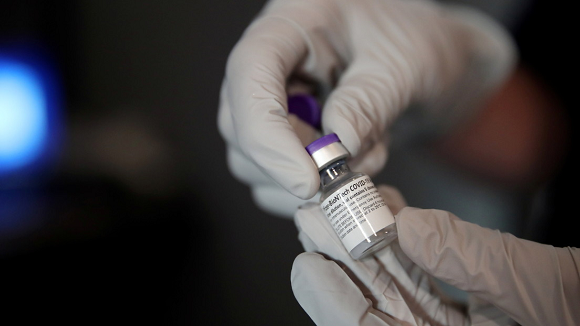
A vial of COVID-19 vaccine from Pfizer and BioNTech, Boston, Massachusetts, USA, on December 16, 2020. Illustrative image: Craig F. Walker/Pool / Reuters
The word we all speak today with hope is “vaccine.” We have had an absolutely extraordinary 2020’s year. An unexpected and unprecedented pandemic has changed everything, in almost every way for the worse, although there also have been some good consequences. The political defeat of some enemies of our country who did not even know how to lead their powerful country in these extraordinary conditions may have been influenced by this factor, and that is a good consequence. That and the vaccines, four of them Cuban, mean a more optimistic outlook for 2021 for us. Unfortunately, those who lalready lost or will lose their lives to this pandemic will not be able to take advantage of what little good there is in the remains of this pandemic.
We already know how life originates, how it works and how it manipulates the laws of the rest of the universe to perpetuate itself, more as a system than in its individualities. Within that system of life, viruses appear at a given moment and have their own space. The one that has caused the current pandemic is only one of the many that exist and that have existed, and it will by no means be the last that affects humanity and other living beings. They can arise anywhere and will or will not spread depending on their characteristics and how science influences where they occur.
Molecules are inanimate particles of the nanoworld since their sizes are around one billionth of a meter. Some of them act as the “bricks” and “cement” that make up living organisms. There are many types of molecules that are part of this network and the most unique and complex are proteins (which are the ones that “work” and are also part of the functional structures), fats (which “cement” and store energy), sugars (which cement and hold, but in a much more specialized way, and also accumulate and transport energy), and the so-called “nucleic acids”. The latter are very special and complex molecules whose fundamental function is to accumulate the information of the living system so that all the others can exist.
Viruses are not living beings, but relatively stable aggregates or associations of various types of vital molecules, the fundamental component of which are nucleic acids. In this case, they carry their own information, but foreign to the system of other living organisms. However, they include the ability to self-replicate at the expense of the animal or plant, including us, in which they are housed. They change (or mutate) in the environment in which they develop and out of the many ways in which this happens, the vast majority fail. However, the few mutations that turn out to be successful put the cells they invade at their service to give rise to new viruses. And in that task, it always affects in one way or another the host cell that lent it its resources. If the virus is COVID-19, it seems to affect the cell to such an extent and in such a way that even the ways we defend ourselves against them can kill us.
There is a great debate among virologists about the origin of viruses. Three main hypotheses are usually mentioned: i) The “progressive” hypothesis that states that viruses arose from genes (made up of nucleic acids) in cells that showed the ability to move or transfer to other cells; ii) the “regressive” hypothesis proposes that viruses are genetic remains of dead cell organisms that showed the ability to be assimilated by other living cells and to reproduce there; and iii) the “primary virus” hypothesis proposes that viruses precede cells in evolution: they would have appeared first. For this reason, they may have been the initiating molecular aggregates of the ability to self-reproduce. If this is the correct hypothesis, it would make them predecessors of cells and in conditions of “coevolution” with them, which are their current hosts.
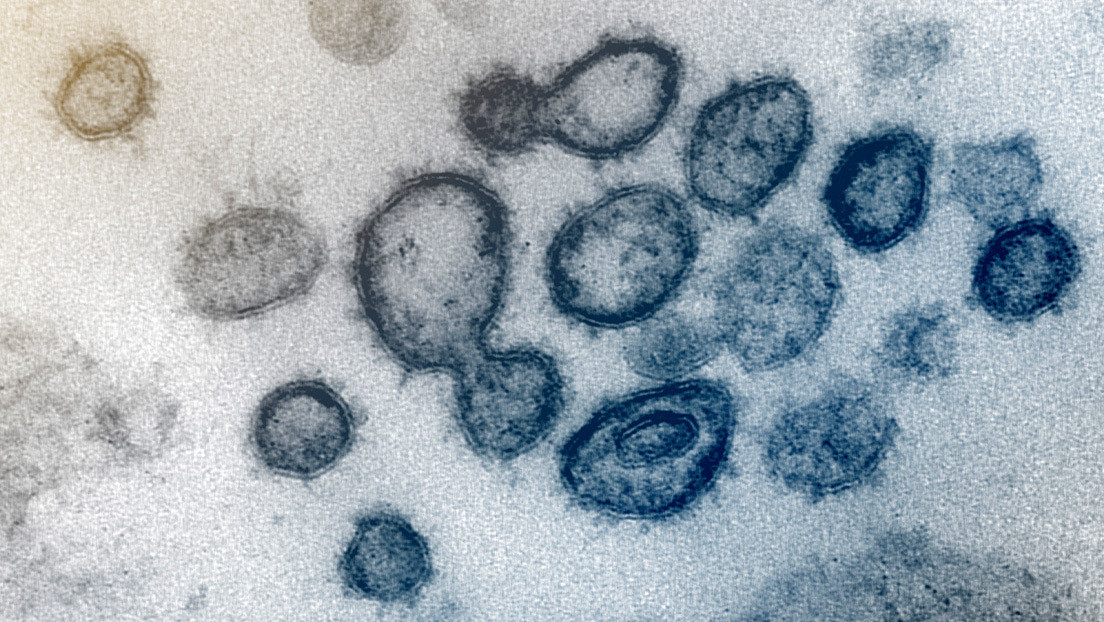
A living system such as the human being that has evolved in the last 3.7 billion years has very efficient ways to defend itself against potentially harmful agents that are carriers of foreign molecules. We do this through what is known as the “immune system.” This has a complex form of action, which can be understood in a simplified way.
The immune system of our body recognizes the vital molecular structures that are our own and not those of others. Our natural “identity card” is in the genes. Once our mother’s egg was fertilized by our father’s sperm, our genes became differentiated from theirs. We constitute ourselves as a new living entity similar to but different from that of our parents. Only a certain part of our cells preserve the identity of our mother.
Among all the information that is transmitted is also that of the system that identifies its own vital molecules with respect to those of any other living entity. These characteristic molecules of bacteria, fungi, viruses and all possible living beings can be of very different types. They are called “antigens.” The wonderful human immune system is capable of identifying foreign antigens that penetrate our body and generating an arsenal of its own components that are responsible for destroying their carriers.
If the invasion is by bacteria, or any other living alien organism, then they identify their foreign antigens, design the appropriate molecules to associate with them, and from there the life span of the invading organism is counted. The intruder can win only if our immune reaction is less efficient than the intruder’s harmful action or if the action of the intruder damages the immune system specifically. Viruses and the cells they infect are identified and killed in a similar way. AIDS, for example, originates from a virus that affects the immune system, and thus it is very difficult to overcome.
How, then, can a disease caused by a virus-like COVID-19 be defeated?
Essentially in two ways: the first is to combat and neutralize the effects of the virus on the diseased organism, which has been attacked. It is achieved with effective treatments. The second is to help identify and destroy the invading species by our own immune weapons. This can be achieved by “teaching” the immune system to do its job, but without the symptoms of the disease that can be fatal. That is “to get vaccinated” against the virus.
 Luis Alberto Cabrera Montero holds a Doctorate Chemical Sciences. He is a Senior Researcher and Full Professor at the University of Havana. He is President of the Scientific Advisory Council of the University of Havana and is a Merit Member and Coordinator of Natural and Exact Sciences of the Academy of Sciences of Cuba. For a full biography, see http://www.academiaciencias.cu/en/node/674
Luis Alberto Cabrera Montero holds a Doctorate Chemical Sciences. He is a Senior Researcher and Full Professor at the University of Havana. He is President of the Scientific Advisory Council of the University of Havana and is a Merit Member and Coordinator of Natural and Exact Sciences of the Academy of Sciences of Cuba. For a full biography, see http://www.academiaciencias.cu/en/node/674
Taking care of my health, and yours

Taking care of my health, I take care of yours
People over 59 years old and children under one year old are essentially symptomatic, but the rest can carry the disease without being suspected. That is why it is vital to respect to the letter the established biosecurity norms
Author:

Ana María Domínguez Cruz
anamaria@juventudrebelde.cu
Translated and edited by Walter Lippmann for CubaNews.
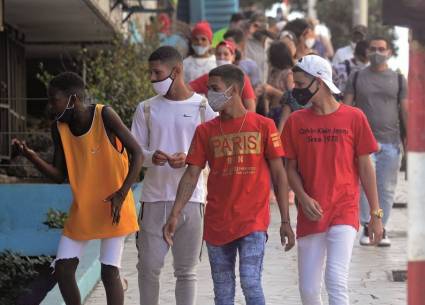
Young people are the ones who most often transit as asymptomatic. Author: Abel Rojas Barallobre Published: 19/01/2021 | 12:03 am
Where were you? Who did you meet? These and many other questions make up the survey that, with rigor and specificity, is carried out on each person who, confirmed as positive to COVID-19 or as a suspect, arrives at a hospital in our country.
It seems routine, but it can be very overwhelming, both for the patient, who suffers from that indescribable mixture of fear, uncertainty and anxiety; and for the health personnel who, with the required clothing, approach him/her without wanting to violate the health protocols, although with the desire to make him/her feel better.
This is what Niurka Molina Aguila, a specialist in II degree in Hygiene and Epidemiology, tells us, who carried out numerous surveys of this type as part of her work at the Pedro Kourí Institute of Tropical Medicine (IPK).
“Do you know what is the most important and, at the same time, most overwhelming, especially for the patient? It is necessary to answer these questions by appealing to the memory as accurately as possible because it is urgent that the answers refer to the 14 days prior to detection. This is the only way we can properly follow the transmission chain,” she assures us.
It is hard to imagine, but this is the day-to-day work of epidemiologists and other specialists who have been working for months in the midst of a scenario as hostile as the one imposed by COVID-19 on the world.
“The greatest danger of this disease lies not only in the very act of suffering it, but in asymptomatic people who, precisely because they do not feel anything that alarms them, carry out their usual activities and have contact with others, and become carriers with the same risk of transmission as those who do manifest the symptoms.
“Who are these asymptomatic people? You, me, that one, her…, but fundamentally the young people. People over 59 years and children under one year are essentially symptomatic, the rest, adolescents, young people and adults of less age, can carry the disease without suspicion. Til/khat is why it is vital to respect to the letter the established biosecurity norms”.
I do not feel, but I suffer
Based on research carried out at the IPK since last year (which has not been published), when cases of the disease began to be reported in the country, it has been assessed during all this time that about 63 percent of the people identified as positive were asymptomatic. This figure, logically, increases as contact searches are carried out through active surveillance, that is, through research.
The also Master in Infectious Diseases specifies that this study covered Havana, fundamentally, but it will continue to evaluate the results according to a better work of prevention and control of COVID-19. “The disease has been known gradually, as people have become sick.
“Much is still unknown, and so describing symptoms is complex. We already see that sometimes the loss of taste and smell are the only symptoms, even, of the disease. Until it was proven in several patients, it could not be described as an associated symptomatology, and this has happened with other aspects.
“The main thing is to respect the established sanitary norms. We cannot get tired of repeating them and enforcing them, because it is the only way we have to make it clear that this disease will not disappear completely, but rather that we will live with it as a seasonal disease, like H1N1 or others.
-Even if they are asymptomatic, can these people suffer from the sequelae of the disease?
-Yes, it is possible. The sequelae left by COVID-19 have already been described in healthy people who suffered from it. Having symptoms or not, does not necessarily condition the appearance of the sequelae, but when in doubt it is better to avoid contagion.
-The vaccine is the hope…
-Because of our human condition, we need hope to move forward. Certainly, we are anxiously waiting for the vaccine, but the population must know that every vaccine has a time to raise the immunity of the organism. That we vaccinate ourselves today does not mean that tomorrow we are already immune to the virus, especially when new strains are reported from time to time.
“There are vaccines that require two doses, and completing the cycle is essential. However, from the appearance of new strains, it is preferred in not few cases to delay the application of the second dose, and this prolongs the immunization process”.
The doctor, also researcher and assistant professor, underlined that until there is not a high number, very high of vaccinated and immunized people, one will not be out of the greatest danger and never absent completely.
The Cuban population must be informed and correctly oriented, based on the results of the researches carried out and the patients’ reactions when they receive the vaccine.
“I do not intend to alarm, but it must be taken into consideration that another new strain of the virus may emerge and the vaccine may not have the capacity to face it, so it will be necessary to continue studying and creating.
“The health measures that are so much repeated today in the different media are for life, because from now on the world will no longer be the same as the one we knew before the pandemic.
“The family must insist on their children and demand that they respect these measures, because one of the greatest dangers of this pandemic is that health services will collapse, as has happened in other nations. Not only do they collapse because people get sick, but because they don’t avoid getting sick.
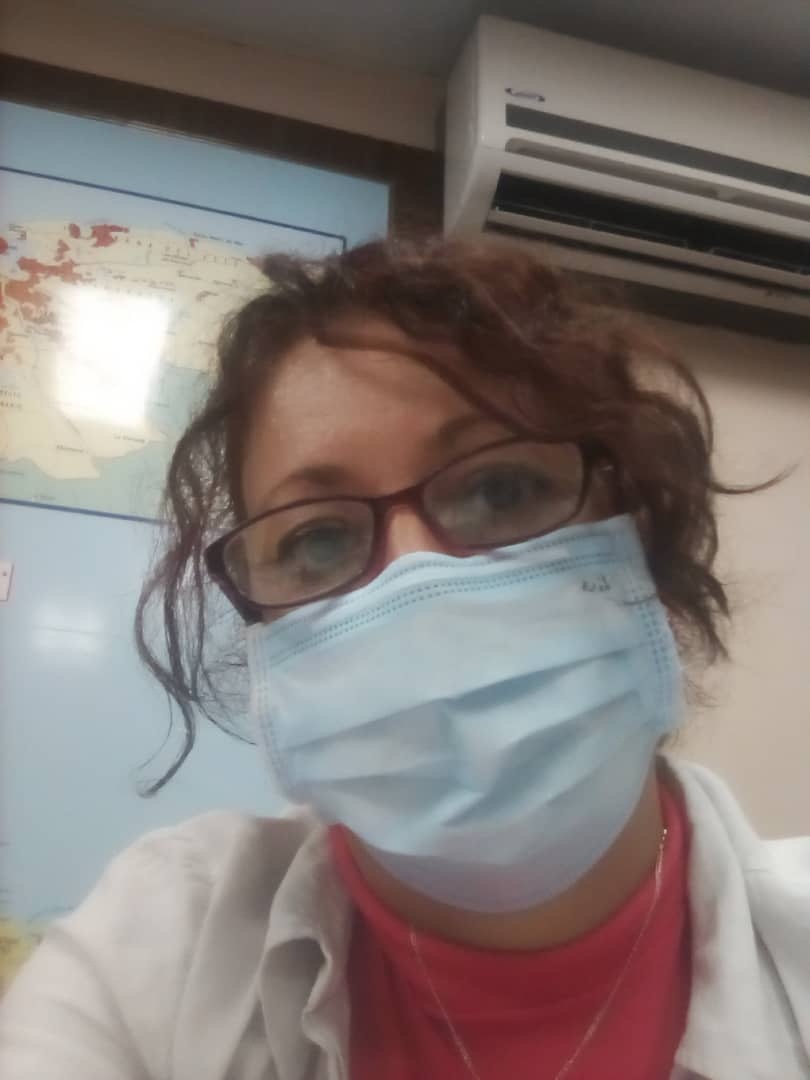
Niurka Molina Aguila, specialist in II degree in Hygiene and Epidemiology, researcher at the Pedro Kourí Institute of Tropical Medicine Photo: Courtesy of the interviewee
Molina Águila also mentioned the process of surrendering patients as convalescents. “Many times it is the time to complete the questionnaire that, when they first arrived at the institution, they could not continue with its completion”.
She emphasized that we should not go to closed places or places where crowds predominate, that the nasobuco should be worn correctly, that frequent hand washing should be deep, that when coughing or sneezing we should protect ourselves with our forearms, that we should maintain distance between one person and another.
“You, me, him, her… any one of us can transmit the disease without knowing it, and that’s what you have to understand. To the extent that someone who lives with other people takes better care of their health, their love and integrity cannot be questioned. These are not times to love as in the old days, but to demonstrate that by taking care of our life, we take care of the lives of others.
“Living for the second time”

After nine days in a coma because of COVID-19:
“Living for a second time”
January 16, 2021
Translated and edited by Walter Lippmann for CubaNews.
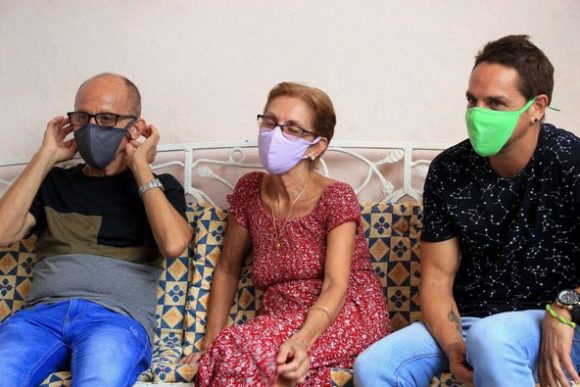
María Lourdes, Antonio and their son Sandir constitute a family and live in the Vedado. Photo: Facebook/Naturaleza Secreta
María Lourdes, Antonio and his son Sandir are a family and live in Vedado, in Havana. They keep in their memory the memory of a terrible fight against COVID-19. Months ago they received a friend from Malaga, Spain, at a time when no positive cases of SARS-CoV-2 had been reported in that city and through her they were infected.
María Lourdes, 64 years old, is hypertensive, has a slight heart failure and therefore it was feared that the disease in her case would manifest itself in a more aggressive way. However, it was Antonio -without any comorbidity- who experienced more evident symptoms. He stopped eating, had pains all over his body, fever, a lot of dry cough, numerous diarrheas, all of which led him to intensive care and nine days in a coma.
Doctors told his family to prepare for the worst. We share with you his testimony, which is part of the recently completed documentary Parallel Stories, which tells the stories of several people who were sick with COVID-19:
“The anguish, the suffering, the strongest tragedy was for the two of them, who were aware that I was in an extremely critical situation, and my younger children who were in Mexico and were totally desperate, totally unhinged. They made a huge chain of people so that they would have me in their prayers, in their hearts, that also helps.
I did not even know I was in the Naval Hospital, I believed that I was in a therapy room in a totally deserted place that was guarded by soldiers, the things I thought. I in front of me there was a tree that I imagined as a woman with many arms, who danced in front of me as if mocking and I closed my eyes and all those leaves became thousands and thousands of coronaviruses.
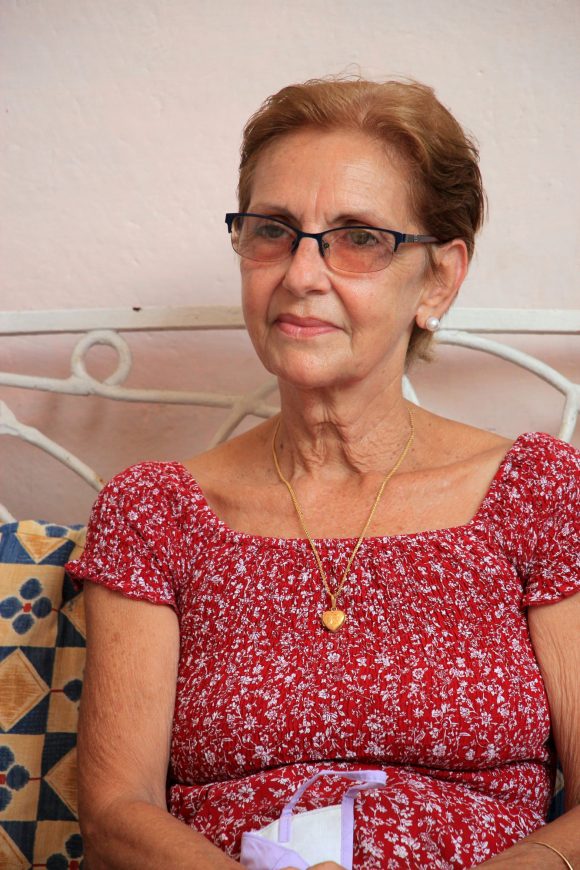
María Lourdes, wife of Antonio, convalescent of COVID-19. Photo: Facebook/Naturaleza Secreta
When I came to my senses in the midst of the gravity, that I came out of the coma, that they took away the intubation, the first thing I thought about is her (his wife) and that was for me the most critical moment, in which I think she had died. Because of her basic disease and heart problems, I thought I had lost her. She is the mother of my children, but she has been my partner for 46 years, the other half of my life. I cried in silence, I am a strong man, I consider myself an enthusiastic, fighting person, but I thought that I would never see again what sustains my life, because that is it, the wife, the children, the grandchildren fighting together for life. We think about everything, even about getting rid of the most intimate relationships that we can still have at our age, which are limited, but they are there.
I remember that once I was pricked in the groin, on this side, what I did see was that they were continuously giving me all kinds of medication, interferon, antibiotics, I don’t know how many, I’m not exaggerating, I think that every day they were 14, 15 times that they came to give me medication. When I came out of gravity, I had no smell, no palate, I still did not speak, it left me with a lung lesion, I was practically unable to walk for a month, I was able to climb the stairs of this house after a month, skin lesions, I could not sleep, sleep was disturbed.
I am a man of dreams, I had dreams before the pandemic and I still have them, in all aspects of life, the day I don’t have dreams is not worth living and there was a moment, I will tell you honestly, after you put it or not in the interview, when I thought that values had been lost, all of them: moral, spiritual, solidarity, to help your neighbor, to cooperate, to share your bread and your soul, and I have seen how the neighbors have come without you calling them, without you asking them anything, knocking on your door and sometimes without asking them anything they said: I brought you this, I threw away the garbage, I found you the food, what do you want? That spirit. The artisans who made 10 beds for a hospital, the cooperative that left with a food truck for an old people’s home, that spirit of solidarity that was there, that I thought was like baby teeth, that were falling out, because they didn’t have any calcium, and yet it was enough for this situation to happen, unfortunately, for that spirit to come out again with more strength than ever.
I felt as if those nurses, those doctors, the intensive care doctors at the Naval hospital were part of my family. That team of nurses, technicians, doctors, gave me the possibility of living for the second time.
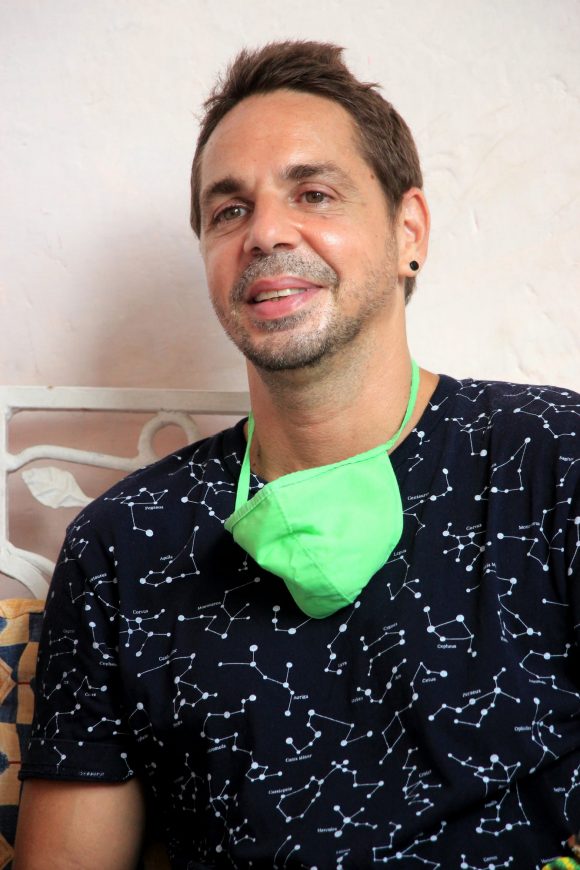
Son of Antonio, convalescent of the COVID-19. Photo: Facebook/Naturaleza Secreta.

The team of nurses, technicians, doctors, gave me the possibility to live for the second time, said Antonio, convalescent of COVID-19. Photo: Facebook/Naturaleza Secreta.
2500+ French defy coronavirus restrictions

France: More than 2,500 people defy coronavirus restrictions at illegal holiday
France introduced fairly strict rules in mid-December to curb the spread of the coronavirus, including a curfew from 8:00 p.m. to 6:00 a.m., as it has been one of the European countries most affected by the pandemic, reporting more than 2,600,000 cases of COVID-19 and at least 64,892 deaths
Author: Web Editor | internet@granma.cuJanuary 3, 2021 09:01:14
Translated and edited by Walter Lippmann for CubaNews.

Photo: Getty Images
The French police intervened in an illegal New Year’s Eve party held at an industrial warehouse in Lieuron, northwest of the country, where about 2500 people broke the health restrictions imposed by the coronavirus, reports the BBC news portal Mundo.
Some of those attending the massive celebration came from Spain and the United Kingdom.
At least three police officers were injured. A statement from local authorities details that the police faced “fierce hostility from many in attendance.
The organizers of the event were identified, and participants were fined as they left the site.
MORE THAN 1200 FINES ISSUED FOR VIOLATING SANITARY MEASURES
More than 1,200 fines were issued for failing to observe curfew, not wearing a mask and attending an illegal meeting, Interior Minister Gérald Darmanin said on a tweet.
He reported that the police seized trucks, sound equipment and power generators at the scene, and that they were investigating the events.
The authorities reported that they had opened a cordon sanitaire around the party and urged all those who attended the event to remain isolated for seven days.
One of the participants, who identified herself as Jo, told AFP that “very few had respected social distancing” during the time of the event.
Another interviewee said that the party was “very well organized” and that there were even food stands inside.
The Ministry of the Interior organized an emergency meeting and later all the party’s vehicle exits were blocked while the police tried to control the situation.
FRANCE INTRODUCED A CURFEW FROM MID-DECEMBER
France introduced fairly strict rules in mid-December to curb the advance of the coronavirus, including a curfew from 8:00 p.m. to 6:00 a.m.
More than 100,000 police officers were deployed throughout the country to enforce the curfew and break up the holiday season.
The French police are ordered to end the underground parties as soon as they receive a complaint, and are also tasked with fining participants and identifying the organizers.
France has been one of the European countries most affected by the pandemic, registering more than 2,600,000 cases of COVID-19 and at least 64,892 deaths.
The most dangerous professions

The most dangerous professions in the world in 2020
None of the murdered, disappeared, assaulted, or imprisoned communicators without cause, despite what the barometer of Reporters without Borders indicates, is Cuban
Author: Raúl Antonio Capote | internacionales@granma.cu
January 4, 2021 23:01:57
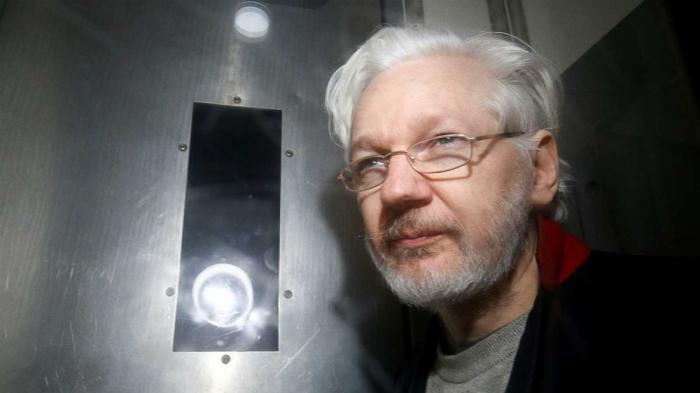
Julian Assange resists the oppression of journalism professionals committed to the truth Photo: reuters
According to the barometer of press freedom violations, website of the NGO, Reporters without Borders (RSF), 51 journalists were killed in 2020 and 400 were imprisoned. The source itself stops to list arbitrary detentions, disappearances, torture, mistreatment and other methods, country by country.
The subject of the moment draws attention, that of the founder of Wikileaks, Julian Assange, who suffers a marked deterioration of his health in the prison where he is held, in Great Britain, for which the judge in the case, Vanessa Baraitser, accepted the diagnosis of the psychiatrists and ruled to prohibit the transfer to the U.S., due to the high risk of suicide.
The same judge described the judicial process as defective and punitive, but did not grant him bail, since the Australian journalist faces charges in the U.S. country for the leaking of thousands of classified documents in 2010 and 2011.
The other side of the story is the proposal by Mexican President Andres Manuel Lopez Obrador, who asked for Assange’s freedom and offered his country to grant him political asylum.
However, RWB does not refer to the case, but marks Cuba in black along with other countries, symbolized as the worst violators of that freedom, although none of its figures include the Cuban archipelago.
The explicit contradiction in the information on the RSF website demonstrates the double standards and political intent with which this data is measured and the information is manipulated with the aim of demonizing the Cuban Revolution.
On the other hand, the United Nations Educational, Scientific and Cultural Organization (UNESCO) reported, on December 23, that 59 journalists were killed in 2020, four of them women. There is a difference of eight between the two reports.
According to UNESCO data, during the last ten years, 888 journalists and media workers, that is, one every four days, were killed.
These crimes continue to be committed with total impunity, according to the report on the safety of journalists, published in November by the UN agency, which shows that in 2020 there were no consequences in 87% of the cases.
The agency reflected the increase in harassment and attacks on information professionals, for example, in the attacks they suffered during the coverage of protest demonstrations in Chile, where 90 attacks were reported, and the case of the Black Lives Matter mobilizations, where up to 500 different attacks against the press occurred.
The document of the multilateral organization detailed that, in the first half of the year, press workers were attacked in 125 protests held in 65 countries.
The Secretary-General of the United Nations recently asked all the governments of the world to release, immediately, the journalists who have been arrested for carrying out their professional work. “Many have been subjected to harassment, acts of intimidation, sanctions, killings and also arbitrary arrests. We know that prisoners, detainees and prisoners, in general, are very vulnerable to the rapid spread of the virus,” said António Guterres.
It should be noted that none of these murdered, disappeared, assaulted or imprisoned communicators without cause, despite what the barometer of Reporters without Borders indicates, is Cuban. The last journalist murdered in the Greater Antilles fell victim to Fulgencio Batista’s police in 1958.
Health workers, the most dangerous job in 2020
Although practicing journalism remains an extremely dangerous profession, in the year that ended, health workers contributed, through their dedication and courageous stand in the face of the COVID-19 pandemic, the greatest number of victims.
At least 7,000 of them have died from COVID-19 in the world, with Mexico being the hardest-hit country, according to a recently released study by Amnesty International.
Behind Mexico, the study places the United States (1,077 deaths), United Kingdom (649), Brazil (634), Russia (631), India (573), South Africa (240), Italy (188), Peru (183), Iran (164) and Egypt (159). Cubans did not add to this last statistic either.
It is not a matter of informative curiosity, a simple coincidence or mere chauvinism on our part, it is a reality marked by results, it has to do with the culture of socialism that places human being in first place, in the center of all priorities.
Sources: RT, RSF Barometer and reports from the UN.
Subscribe to Blog via Email
| M | T | W | T | F | S | S |
|---|---|---|---|---|---|---|
| 1 | 2 | 3 | 4 | 5 | 6 | 7 |
| 8 | 9 | 10 | 11 | 12 | 13 | 14 |
| 15 | 16 | 17 | 18 | 19 | 20 | 21 |
| 22 | 23 | 24 | 25 | 26 | 27 | 28 |
| 29 | 30 | 31 | ||||
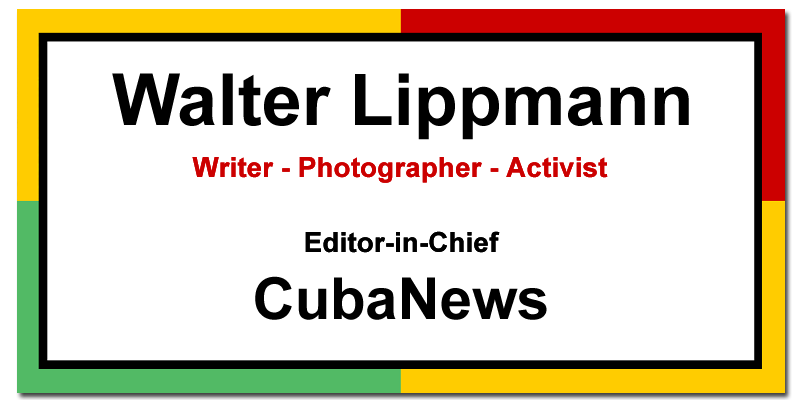
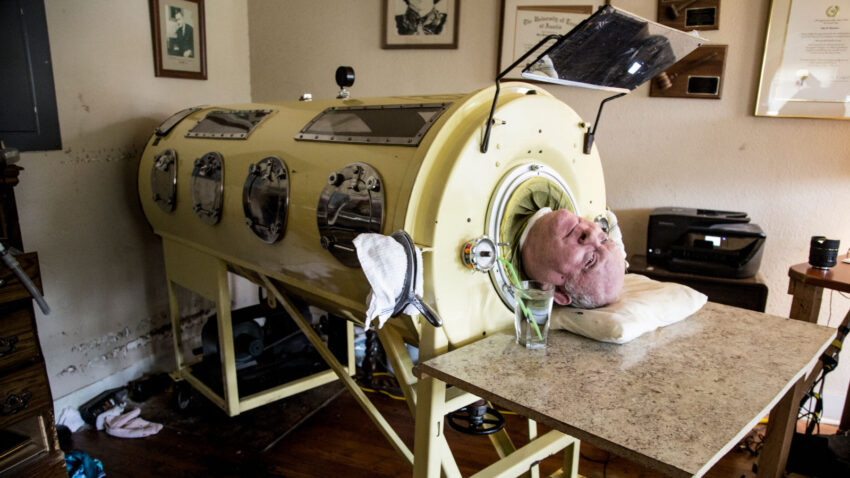
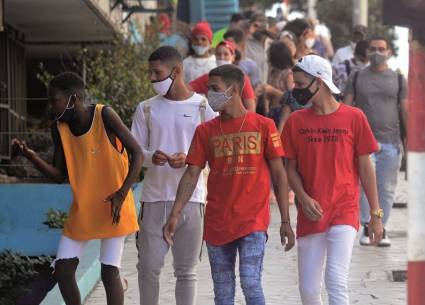
You must be logged in to post a comment.